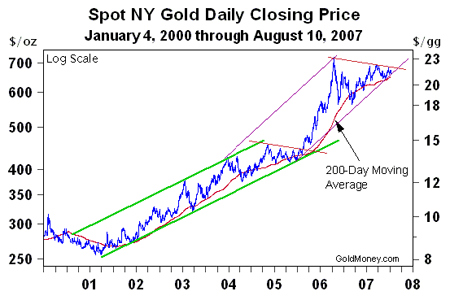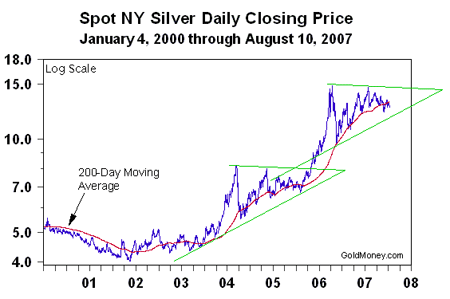I urge everyone to read an article about counterparty risk that I posted this past Friday to Kitco.com. It's entitled 'As Financial Tremors Reverberate, Focus on Counterparty Risk'. Here's the link: As financial tremors reverberate, focus on counterparty risk
Counterparty risk is becoming increasingly important. As the subprime mortgage contagion continues to spread, there is growing nervousness about all types of financial assets, and rightly so. No one yet knows how big the subprime problem even is let alone how big it will become. Not surprisingly in this present environment promises are being called into question. Counterparty risk has become a growing worry, particularly as the subprime mess spreads in ways heretofore unexpected.
For example, one European money market fund was closed after reportedly losing 30% of its value because it held commercial paper backed by subprime loans. Money market funds are of course supposed to be safe and without price risk. In other words, the principal one invests is not supposed to be diminished, and when shareholders decide to cash-out, everyone expects to receive their principal and interest because money markets funds only buy interest-bearing paper and not equities. But as the shareholders of this European money market fund have now found out, their fund's net asset value dropped substantially because the fund owned commercial paper backed by subprime mortgages. So the question arises, how many more money market funds around the globe are going to be infected by the growing subprime contagion because they own commercial paper backed by subprime loans?
MoneyWeek
Subscribe to MoneyWeek today and get your first six magazine issues absolutely FREE

Sign up to Money Morning
Don't miss the latest investment and personal finances news, market analysis, plus money-saving tips with our free twice-daily newsletter
Don't miss the latest investment and personal finances news, market analysis, plus money-saving tips with our free twice-daily newsletter
As today's issue of Barron's notes: 'The subprime mess also recalls another crisis - the virtual collapse of the commercial-paper market in the wake of the Penn Central bankruptcy of 1970. Back then, the paper market consisted of relatively simple short-term corporate IOUs. Now, so-called asset-backed commercial paper is backed by all manner of things, from credit cards and auto loans to collateralized debt obligations, and comprises over half the commercial paper outstanding. Moreover, notes MacroMavens' Stephanie Pomboy, money-market funds own 27% of commercial paper outstanding.'
Gold is a barometer for monetary problems of all sorts. Its price rises whenever there are worries about inflation, bank problems, a credit bubble bursting or whatever, because people opt for the safety of gold. Like a canary in a coal mine, a rising gold price warns of troubles ahead. That's why central banks have been capping the gold price, which explains why gold isn't flying higher as one would expect it should be doing as the monetary troubles mount.
It's easier for central banks to 'kill the messenger' than to fix the problems. After all, to fix today's monetary problems would mean admitting the system is broken because there no longer is the indispensable discipline needed to control credit growth as there was under the classical gold standard.
It is this lack of discipline in credit growth that expands the money supply and thereby creates monetary problems. So rather than fix the system or to acknowledge that it is part of the problem, the Federal Reserve's response, for example, has been to sweep the problem under the rug by stopping its reports on M3, which ShadowStats.com reports is now growing by a highly inflationary 12.8% per annum.
As the subprime woes mounted this past week, gold did finally rise sharply on Friday, but most of this week central bank capping efforts got a helping hand. When banks sell collateral after margin calls are not met, the most liquid and easy to sell assets go first, and gold is always in that category. Its unparalleled liquidity is one of gold's attributes. By selling gold margin clerks were throwing the baby out with the bathwater, but that mentality changed by Friday.
The margin selling was done, and central bank selling was not enough the keep the tidal wave of buying from driving gold higher, that is, at least until after the London pm fix. With the physical market closed, central banks did manage to 'circle the wagons' and keep gold from climbing any higher the rest of Friday. But the following chart indicates that the underlying buying pressure may be too strong for central banks to keep a lid on gold at these prices much longer.

Note the sloping red line that has contained gold since its May 2006 high. It is similar to the one that contained gold from mid-2004 until August 2005. Once that previous red line was hurdled, gold soared. I expect the same result this time too.
The silver chart also remains bullish. It continues to consolidate within a pennant formation, as it works toward what I expect will be its eventual upside breakout.

In summary, the credit markets indicate that a wheel looks ready to come off the truck. The subprime mortgage contagion is spreading, and people are increasingly worrying about their financial assets, i.e., those reliant upon a promise. So why worry? Own gold and silver instead.
James Turk is the Founder & Chairman of GoldMoney.com. He is the co-author of The Coming Collapse of the Dollar.
Get the latest financial news, insights and expert analysis from our award-winning MoneyWeek team, to help you understand what really matters when it comes to your finances.
MoneyWeek is written by a team of experienced and award-winning journalists, plus expert columnists. As well as daily digital news and features, MoneyWeek also publishes a weekly magazine, covering investing and personal finance. From share tips, pensions, gold to practical investment tips - we provide a round-up to help you make money and keep it.
-
 The most influential people of 2025
The most influential people of 2025Here are the most influential people of 2025, from New York's mayor-elect Zohran Mamdani to Japan’s Iron Lady Sanae Takaichi
-
 Millions of parents are missing out on up to £720 a year in extra pension cash – are you affected?
Millions of parents are missing out on up to £720 a year in extra pension cash – are you affected?A mum who narrowly missed out on the pension boost said she “never knew the government rule existed” and wants other parents to use it

